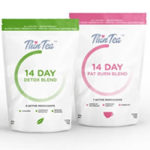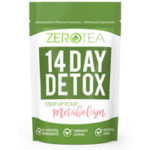Should You Be Drinking Matcha Tea Instead Of Green Tea?
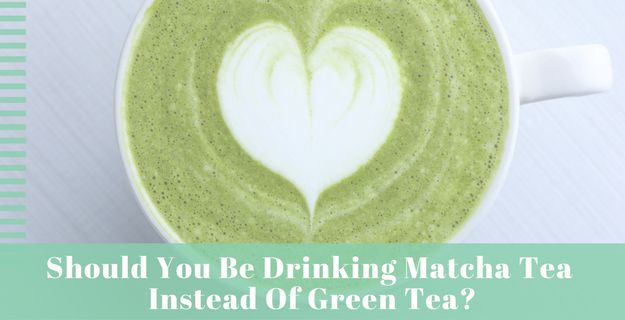
Matcha tea is the newest superfood trend that’s sweeping the nation.
It’s in teas, lattes, cupcakes, cream puffs, ice cream, smoothies, sushi, and even facial products.
And it’s leaving insane health benefits in its wake.
Are you getting all this green goodness, yet?
Well, first off, it’s important to know what matcha really is.
Matcha is a very special type of tea. (Check out this article to get a quick down low on all the main types of tea and all their amazing benefits.)
Some people are die-hard matcha fans and others are kind of clueless.
But you’re not alone if you have no idea what matcha is.
I had no earthly idea until my first job as a glorified deliverer of heavenly caffeinated beverages aka a Starbucks barista.
At the time, 1) no one really knew what the heck matcha was and 2) it looks really weird.
There’s a Starbucks Green Tea Matcha Powder latte.
And it basically looks like you threw Shrek in a blender, ground him up into tiny pieces, and served him as a drink.
Weird analogy, I know, but keep reading to understand.
There were only a few customers who EVER ordered Green Tea Lattes (granted this goes back a quite a few years ;)). And those select customers just oozed health and yogi-ness from their soul.
The green tea lattes consisted of whatever type of milk (or milk alternative) and this ground up Shrek powder.
And slowly I started learning more about this green, potent powder and how it’s actually incredibly healthy.
I started making my own matcha tea concoctions that I lovingly coined “Swamp Water”.
See the Shrek theme now? “What are you doing in muh swamp?!”
Funny enough, I’d be sitting on my break sipping on my disgusting, murky looking, green Swamp Water and customers would actually walk up to me and ask what it was??
Curiosity benefitted the cat (aka the customer) in this case and a just a touch of embarrassment coming from my end.
I told them what it was but that it wasn’t on the menu because I invented it.
And much to my surprise, people actually ordered it!
From then on, I knew I was destined to spread the word about tea.
Now that storytime is over, let’s learn a little more about this special tea.
What’s Matcha Tea?
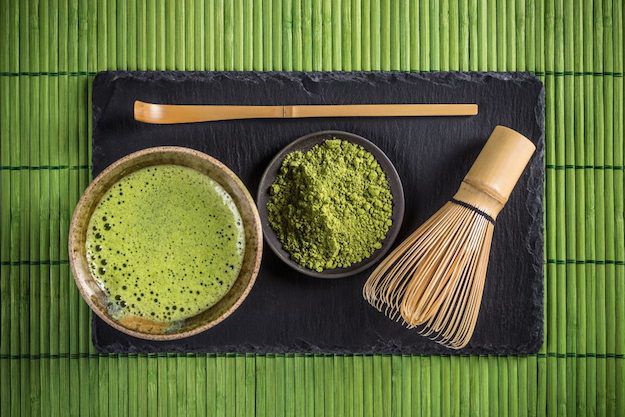
Image via World Tea News
This tea may be new to us but it has been around for centuries.
It’s a robustly fragrant powdered tea with slightly grassy undertones.
It has an incredibly brilliant, bright green color to it due to its high chlorophyll content.
We usually associate the color green with health (and green light…GO) and this couldn’t be a better example.
So take this tea’s signal and GO green!
Matcha possesses a rich, unique flavor accompanied with highly esteemed, nutrient-dense qualities that have powerful effects on the body.
It’s used as a centerpiece for spiritual Japanese tea ceremonies, where they blend it with a delicate bamboo whisk to create a deep green, luscious froth.
What’s The Difference Between Matcha Tea and Green Tea?

Image via Healthline
Both teas are classified as “green tea” and come from the same evergreen shrub, Camellia sinensis, but they’re actually quite different from each other.
It’s the way the leaves are processed that makes the drastic difference between the two teas.
Green tea is made from the extracts of the Camellia sinensis tree leaves.
Matcha green tea is made 100% entirely of the Camellia sinensis leaves.
Tea is produced from either sun-grown plants or shade-grown plants.
This greatly affects the properties and characteristics of the tea.
During matcha production, the leaves are shaded from the sun during the last 3 weeks before harvest.
The shaded growth period boosts the amount of chlorophyll (leading to that vibrant green color), along with increased theanine and caffeine content.
The plants are then steamed, stemmed, and deveined. Again the entire leaf of the plant is being used.
Lastly, the tea leaves are carefully ground up with stone wheels into a fine powder and stored away to prevent any damage from oxygen and light.
This special process is short and sweet (other teas go through much more processing) and preserves the antioxidant properties and gorgeous green color.
Since you’re getting the entire leaf while drinking matcha tea it means you’re getting 100% of the nutrients it naturally possesses.
In particular, it’s rich in antioxidant-filled flavonoids, which are made up of potent catechins and epigallocatechin gallate (EGCG).
These are highly touted compounds that have been researched for their full-body health benefits.
Another difference between the teas is when you brew green tea, a lot of goodness is left in the tea bag once you pull it out of your cup. So you’re basically tossing vital nutrients into the trash when you throw away your tea bag.
Instead, with matcha, you’re getting the leaf, the whole leaf, and nothing but the leaf (so help us tea gods).
So that leaves (no pun intended) us with 10x the antioxidant power of regular brewed tea and 100+ times the normal levels of EGCG. You also get a little bit of fiber as an extra potty perk.
Matcha is much more concentrated and potent compared to regular green tea.
So you get more benefits from a smaller amount! We call that a win-win!
Speaking of benefits, what are they?
The Benefits Of Drinking Matcha Tea

Image via Reader’s Digest
You’re probably well aware of the amazing list of benefits that green tea has.
And matcha is the highest quality powdered green tea you can buy.
Here are some of the most notable benefits…
- High In Free Radical Fighting Antioxidants
As we mentioned earlier, matcha powder has a powerful fleet of antioxidants.
These readily fight off dangerous free radicals before they have a chance to damage vital cells.
Oxygen radical absorbance capacity (ORAC) is a means to measure antioxidant capabilities.
This powdered tea tops the charts along with other superfoods coming in at about 1348 units per gram (or serving).
These magical little enzymes and nutrients protect us from UV radiation, signs of aging, numerous diseases like heart disease and high cholesterol, and even certain types of cancer such as colon, bladder, skin, esophageal, and breast.
- Burns Calories And Torches Fat
Drinking matcha powder has been shown to boost metabolism, which burns calories and helps burn fat.
Studies suggest matcha burns fat up to 4x faster than average.
That’s a tea after my own heart!
It’s safe and natural and doesn’t have any nasty side effects like other diet products that lead to high blood pressure and elevated heart rate.
- Detoxifies The Body
This tea is an effective and natural way to cleanse and detoxify the body.
It effectively removes chemical toxins and heavy metals from the system.
We could all benefit from some healthy detox in our lives!
- Calms And Relaxes
This superfood has a unique ability to calm the mind, relax the body, and aid in meaningful meditation.
However, while doing so, it also allows you to remain alert.
The tea leaves contain an amino acid called L-Theanine, which makes all this possible.
So you can relax more easily without the drowsiness you get from other products and supplements.
- Boosts Mood, Memory, And Concentration
L-Theanine has some other tricks up its sleeve.
It just so happens to produce serotonin and dopamine.
These chemicals work to improve memory, enhance overall mood, and increase levels of concentration.
- Organic Energy
Matcha also takes the cake as the healthiest energy drink!
This tea has a special set of phytonutrients that makes the caffeine absorb much differently and healthier than black tea or coffee.
The caffeine attaches to larger catechin molecules and slowly releases into the bloodstream.
This provides you with 6 – 8 hours of sustained energy, mental clarity, and a calm attentiveness.
There’s also no crash afterwards like with other energy drinks, caffeinated beverages, and stimulants.
Matcha has about 45 – 65 mg (milligrams) of caffeine per cup (8 fl oz.).
This is more than your standard cup of green tea, which is around 25 – 35 mg of caffeine.
As a comparison, black tea is about 50 mg and a regular cup of coffee ranges from 95 – 200 mg.
The Final Takeaway
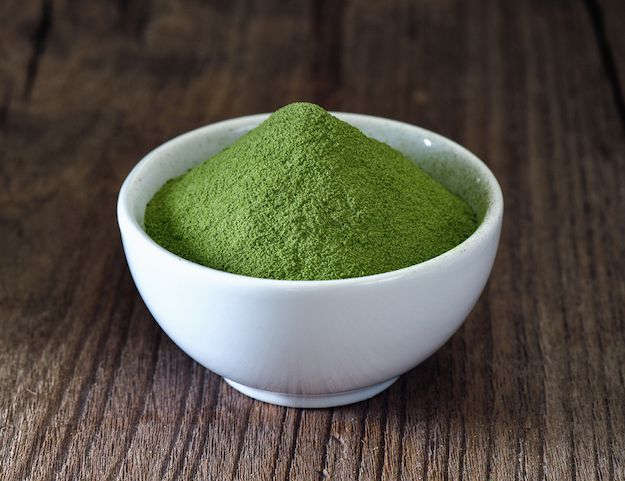
Image via Fit Life
As you know, matcha tea is definitely a powerful, health inducing superfood worthy of its title.
But should you replace your daily cup of green tea with matcha?
Well, if you want the benefits of green tea, but on steroids, then YES!
This tea serves up wonderful qualities that are even more nutrient-packed than green tea.
You get more beneficial bang for your health buck.
That being said, green tea is still incredibly healthy, so there’s no need to shun green tea altogether.
If you’re an avid tea drinker (or a novice) do yourself a favor and add a little swampy, matcha, green goodness into your life and reap the awesome benefits!
Category: Types of Tea








